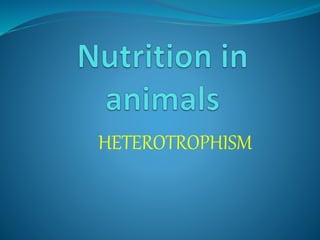
Nutrition in animals by Ratep Ken
- 2. Heterotrophs are the organisms that use this mode of nutrition. All animals are heterotrophs. Heterotrophism is a mode of nutrition where organisms take in complex food substances such as carbohydrates, proteins and fat obtained from either plants or animals. They do not make their own food, therefore feed on already made food. These materials are digested into simple soluble and absorbable molecules.
- 3. Holozoic - where solid complex substances are ingested, digested and assimilated in the body. Saprophytism – where organisms obtain nutrients from dead decaying matter thus causing decomposition. Parasitism – an association where the minor organism (parasite) feeds on or obtain nutrients from tissues of another living organism (host). Symbiosis – an association where two organisms live together and mutually benefit. Heterotrophic modes of nutrition includes;
- 4. Nutrition in humans and other animals Animals are classified according to the type of food they take. They include; Herbivores. Carnivores. Omnivores These animals have four different types of teeth (teeth with different size and shape) thus referred to as heterodonts. The teeth include; Incisors Canines Pre-molars Molars Homodonts have teeth of same size and shape.
- 5. Dentition Refers to description of types of teeth, their arrangement on the jaw and their specialization (function). Incisors – flat, chisel shaped teeth with sharp ridged edges for cutting and biting. Have one root as canines. Canines – conical shaped with sharp pointed tips for seizing prey and tearing flesh especially in carnivores. Pre-molars – have broad surface and are ridged with cusps. Are used for crushing and grinding food. Have two roots. Molars – have the same characteristics and functions as pre-molars only that they have three roots.
- 6. DENTAL FORMULA Describes the number, type and position of teeth in the jaw of mammals. The record denotes half the total number on the upper and lower jaws. Abbreviations are; incisors (i), canines (c), (pm) premolars and (m) molars. Dentition determine the mode of feeding of an animal. That is whether herbivorous, carnivorous or omnivorous. e.g. i 0/4 , c 0/0 , pm 3/3 , m 2/3 = 30 tells the animal is a herbivore (has a herbivorous mode of feeding) due to lack of canines. To get 30; i(0+4)x2 + c(0+0)x2 + pm(3+3)x2 + m(2+3)x2 = 8 + 0 + 12 + 10=30.
- 7. Herbivores Feed exclusively on vegetation. Are grouped into two; Grazers – those feed on grasses e.g. zebras, donkeys and cattle Browsers – feed on shrubs and herbs e.g. giraffes, goats and antelope. Their adaptations to this mode of feeding includes the following.
- 8. Lack upper incisors and instead have a horny pad against which lower incisors press and cut grass. Have a long tongue that assist in cutting, turning and moving grass during grinding. Have a diastema (a toothless gap in the lower jaw separating the canines and premolars) that assist the tongue in the above functions. Molars and premolars have broad cusps and ridges for grinding. Jaws move side by side to enhance grinding. Enamel is continuously replenished to maintain teeth height and counteract heavy wear and tear of teeth.
- 9. Carnivores Feed exclusively on flesh (meat) and most are hunters. Adaptations to this mode of feeding includes; Are fast runners and have well developed leg muscles. Have strong jaws to grasp prey. Have chisel-shaped and closely fitting incisors to seize prey and strip flesh from bones. Canines are long conical (sharp) and curved to grasp, kill and tear prey. Have carnassial teeth – special premolars with smooth sides and sharp edges to slice flesh and crush bones. Their strong jaws are attached to powerful muscles that move the jaw up and down by snapping.
- 10. Omnivores Feed on both vegetation and flesh. Have two sets of teeth; milk(20 for human) and permanent (32) teeth. Milk teeth are lost at of between 6-12 years and replaced by the permanent teeth. Teeth have characteristics of both carnivores and herbivores. Activity Suggest the mode of feeding of animal with following characteristics; long curved and sharply pointed canines, small closely fitting incisors, narrow molars and premolars with cusps.
- 11. STRUCTURE OF A TOOTH EXTERNAL STRUCTURE It is made up of three distinct regions; Crown – the section that projects above the gum. It is covered with hard, non-living material known as enamel made of calcium carbonate and phosphate. Enamel protects inner tooth and forms the surface for biting and grinding. Root - the part that is embedded in the jaw. Neck – the region between the root and crown.
- 12. INTERNAL STRUCTURE Enamel - It is a white, hard and non-living material made of calcium carbonate and phosphate. Enamel protects inner tooth and forms the surface for biting and grinding. Dentine – It is a layer of tissue beneath the enamel and surrounding the pulp cavity. It extends to form the root and consists of living cells. Pulp cavity – It is found within the dentine. It contains nerve endings and blood vessels. The blood vessels supply nutrients to dentine and remove the waste products. Nerves detect heat, cold and pain. Pulp plays part in nourishment, defense, sensation of pain and formation of dentine. Cement – It is the outer layer of the root. It protects the tooth and provides rough surface for anchorage of the tooth in the jaw. It is surrounded by supporting fibres.
- 13. Structure of a tooth Canine Molar
- 14. Dental Diseases Common dental diseases include the following; Dental carries (tooth decay, cavities). Periodontal disease. This disease is of two types; Pyorrhoea. Gingivitis. Activity Find out the causes and control (dental hygiene) of the above diseases.
- 15. Dental Diseases links http://www.patient.co.uk/doctor/some-dental-and- periodontal-diseases http://en.wikipedia.org/wiki/Tooth_pathology http://www.dentalgentlecare.com/picture_gum_disea se.htm
